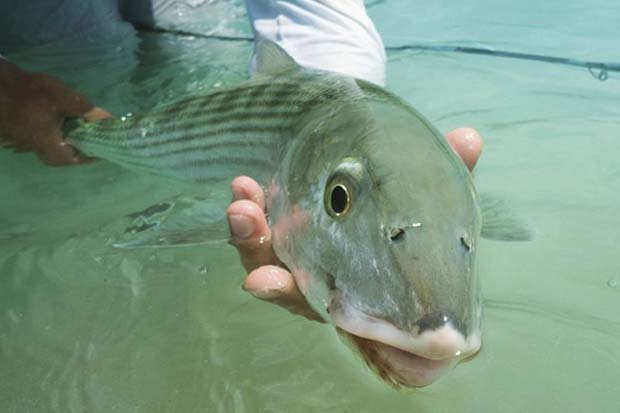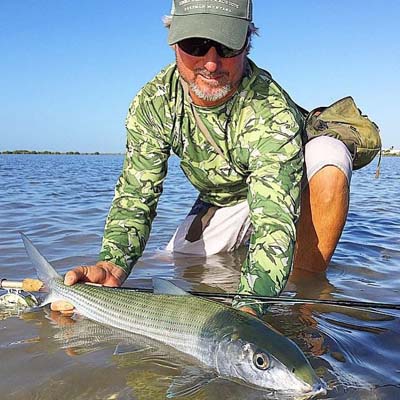[dropcap]B[/dropcap]ringing all the right rods and reels for every conceivable scenario (tarpon, permit, snook, barracuda, snapper, shark) can be extraordinarily expensive. These days, three or four different rod weights + high end reels could easily put you north of $4,000. That is if you live in the Abel, Tibor, Sage, Loomis, Winston neighborhood. In all fairness, though, they each make middle of the road rods and reels, which is where most folks go. We do not live in the well heeled zone so practical is necessary, but that does not mean crappy or cheapskate. We would never buy a poorly made rod or reel, and yes, we know the difference as do you.
Quality fly rods and quality reels are essential ingredients for bonefishing the Bahamas, or any destination. Destination fly fishing venues will not have a fly shop down the street to replace things, so when you travel to fish, be prepared to have what might be needed to be replaced or mended.
From the top; your attire
1. Your hat. A Tilley Wanderer is about $80. It has a wide, 360 degree brim and is extraordinarily well built and is fast dry. A lifetime investment. Ball caps do not protect your ears. Think protect my ears.
2. Polarized glasses. One pair for the boat (salt spray), and one pair for deck or walking the flats with clean glasses. Think brown or amber.
3. A Buff bandana for your face and neck. Most are UPF of 50.
4. Rain jacket (waterproof breathable) and a fleece vest. It does rain, there will be spray, and a 25MPH ride on a 65 degree morning can be amazingly cold.
5. Shirt: Stay with long sleeve, no loud colors, quick dry and comfortable. The mesh interior shirts are very itchy to some.
6. Pants. True Flies’ Captiva Air-Lite II Pant are military grade, and very comfortable as well as quick drying. Think long pants and quick dry – same as shirt. It is the zippers that fail often on lesser quality pants.
7. Simms’ fanny pack is probably the best out there. It is waterproof, no others are. It is also a no frills pack, which we like. It holds a bunch of stuff. It is called Dry Creek Z Hip Pack and MSRP is a scorcher at $200. But dry is far, far better than damp, wet, stinky and ruined.
8. Flats walker shoes: There are a bunch of good ones out there. Get shoes that are very comfortable, lightweight, fishable from a skiff deck, and make sure you break them in before ‘D’ Day. A sock and a Velcro ‘gravel’ guard are a good ideas.
We recommend you closely duplicate the above clothing and travel in one set of them to save on packing. That does not, of course, include more sunglasses, hats, flats shoes or their accoutrements. You will need a pair of Bermuda shorts, sandals and a nice shirt or blouse for dinner. No need to advise on meds and personal items. You know best. And, yes, sunscreen and a hand towel – you will be glad you brought one. Think fish slime and sunscreen on your hands.
Fly Rods: Let the argument begin . . .
The Bahamas, like the Florida Keys, are always windy in the winter. Cold fronts do make it down to the Northerm Bahamas, but usually clear out in two or three days. Some of the biggest bones are caught on those tough days.
On windy days (20 or more MPH), you will have to have tight loops and very fast line speed, especially so if you are 6-, 7- or 8-weight employed.
If you have a deep bending rod (to butt), tight loops and fast line speed will be difficult achieve
Most anglers are in 8- or 9-weight camp. The difference between a 2-weight and a 3-weight is minimal, but as you move up in weights the difference becomes great, so the performance difference of a 7-weight versus a 9-weight or 10-weight is huge.
We prefer 9-weights, and here is why. A nine can punch through wind (even a mid-flex rod), it can handle a tarpon, double digit bone, permit, small shark, cuda or snapper, and it makes for a quick catch and release – saving the bonefish for another day.
We suggest bringing two rods. They have been known to break. Some bring four or five. What good is clutter?
Reel
Hard anodized, T6 solid bar stock aircraft grade 6061 aluminum that is tempered to significantly increase its strength with a sealed drag. 3Tand reels are reasonably priced and we have found them extremely durable with a reliable drag. You do not need a zillion dollar reel for bonefish or the other flats visitors of the Bahamas or Caribbean. A 150 yards of backing will be all you need if in a skiff/flats boat, but a little insurance can be had with fluorocarbon – think tarpon, shark or large permit. Go with larger arbor for more insurance and faster line pick-up.
The most important thing about a reel is “Setting the Drag.” An excellent guide once instructed me to start by setting it at almost free spooling, then yank some line off as hard as you can. If it backlashes – make a quarter turn and repeat until it does not backlash.
Fly line, never an argument there
Floating WF – choose any tropical floater that suits your needs. We bring sink tips for that chance of needing to go deeper.
Pre-tied leaders
You can use knotless these days. The old argument against them no longer holds ANY water. We prefer RIO’s versions, 9- to 12-feet and nothing under 12-pound and nothing over 16-pound. Some advise 14- to 16-foot leaders for spooky animals. What a joke. Try that in a 20 knot wind!
Flies
There are as many for the flats as there are for trouts. Bones, permit and tarpon – think crab, shrimp and small baitfish patterns. If you need help there are three fly shops, all in Florida, that will have what you will need in the Bahamas or Caribbean for bones: Salt Water Fly Tyers, The Fly Shop of Miami, or Florida Keys Outfitters.
Fishing notes
1. Arrive at the dock with rigged rods, as in ready to cast to a sighted fish. Double-check all knots.
2. Hold fly in off hand, and keep at least a rod length of line out of reel. You want to cast with no more than two flase casts.
3. Cut a deal with you boat partner as in 30 or 45 minutes on deck and then switch. When not fishing, you help mind your partners line. Do not shuffle feet or make noise. Use your off deck time to change leader and/or fly.
4. Do not let cooler lid slam.
5. In the skiff, I prefer bare feet; less noise possibilities, and on deck I can feel line if stepped on.
6. Half of your success will be in the hook set. Hoist the rod tip and you will lose more than half the fish. Use strip set, rod tip pointed at the fish and rod tip in the water and you will be a 90-percenter.




